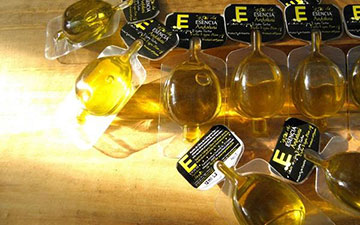
Fluorescence spectra can be used to analyze mixtures of fresh and expired extra-virgin olive oil. [Image: Esencia Andalusí]
Counterfeit extra-virgin olive oil (EVOO) is an economic problem for legitimate oil producers and a potential health concern for consumers. Researchers from the Complutense University of Madrid in Spain and the Scintillon Institute in the U.S. report a new method for measuring adulterants in EVOO using fluorescence spectra and mathematical modeling (Talanta, doi: 10.1016/j.talanta.2018.10.102).
In a proof-of-concept study, José S. Torrecilla and his colleagues recorded the fluorescence spectra of several hundred mixtures of expired (a stand-in for oil adulterants) and fresh EVOO with a briefcase-sized setup containing a 3-D printed sensor and a miniature spectrometer. Because expired oils emit slightly different fluorescence signals than fresh oils, the researchers were able to use the spectra to calculate chaotic parameters for quantifying the amount of expired oil in each mixture.
Counterfeit EVOO and chemical signatures
The EVOO sector has been fighting against counterfeit oil production and fraudulent sales for ages. These criminal practices pose not only an economic burden for the regions that produce olive oil, but they can also pose serious health concerns for those who consume the adulterated product. For example, in 1981, an outbreak of toxic oil syndrome in Spain killed more than 600 people when hazardous industrial oil was refined and sold illegally as olive oil.
In the 1990s, the European Union implemented the protected-designation-of-origin (PDO) traceability label to indicate food quality and authenticity. PDO labeling for EVOO indicates that the oil has a specific geographical origin and a defined chemical composition. Torrecilla and his colleagues say that they can use this chemical “signature”—specifically, the oils’ fluorescence spectra—to identify and quantify EVOO adulteration.
Proof-of-concept testing
The researchers’ proof-of-concept setup consists of a 3-D-printed sensor containing a small laser diode and a quartz cuvette, as well as a miniature fiber spectrometer and external software for data treatment and analysis.
First, the researchers prepared 459 mixtures of three different fresh and three different expired PDO EVOOs. The mixtures ranged from 1-percent to 17-percent-by-weight expired EVOO. They placed samples from each mixture in the quartz cuvette and irradiated with 405-nm light from the laser diode. Pigments in the EVOO samples (such as chlorophylls and carotenoids) absorbed light from the laser and emitted fluorescence signals with peaks around 680 nm, as detected by the fiber spectrometer.
The researchers collected three spectrometer measurements for each of the 459 mixtures and averaged them to get signature spectra. They then used the signature spectra to determine chaotic parameters for the system. Using these parameters, the researchers were able to calculate chaotic parameter-based models that could accurately estimate the concentration of expired EVOO in all of the mixtures.
The models were evaluated and confirmed using a cross-validation method, which gave them a quantification error of less than 10 percent. Torrecilla and his team believe that these results show that their setup could someday be used for cost-effective on-site analysis at olive oil mills or for quality control after the oil has been packaged.
